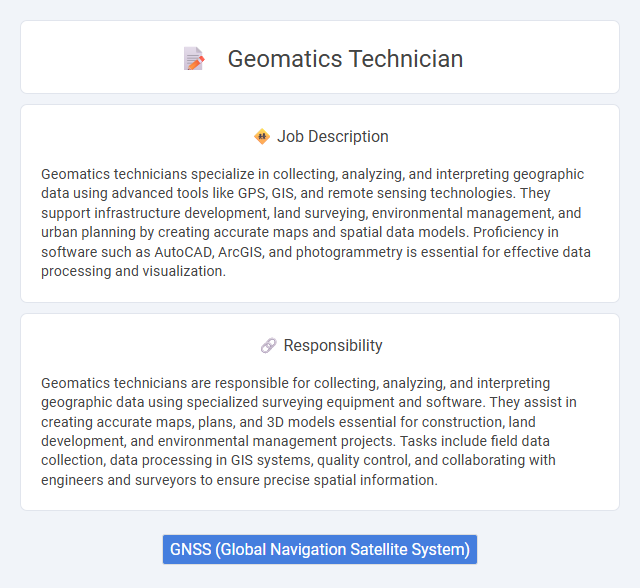
Geomatics technicians specialize in collecting, analyzing, and interpreting geographic data using advanced tools like GPS, GIS, and remote sensing technologies. They support infrastructure development, land surveying, environmental management, and urban planning by creating accurate maps and spatial data models. Proficiency in software such as AutoCAD, ArcGIS, and photogrammetry is essential for effective data processing and visualization.
Geomatics technician roles likely suit individuals with strong analytical skills and an interest in geography and technology. People who enjoy working with precise measurements, data analysis, and fieldwork may find this job fulfilling. Those less comfortable with technical tools or detailed data processes might face challenges in adapting to this profession.
Qualification
A Geomatics technician must have a strong foundation in surveying principles, cartography, and geographic information systems (GIS) software such as AutoCAD, ArcGIS, and GPS technology. Typically, a diploma or associate degree in geomatics, surveying, or a related field is required, alongside proficiency in data analysis and field measurements. Certification from recognized bodies like the National Society of Professional Surveyors (NSPS) enhances job prospects and validates technical skills.
Responsibility
Geomatics technicians are responsible for collecting, analyzing, and interpreting geographic data using specialized surveying equipment and software. They assist in creating accurate maps, plans, and 3D models essential for construction, land development, and environmental management projects. Tasks include field data collection, data processing in GIS systems, quality control, and collaborating with engineers and surveyors to ensure precise spatial information.
Benefit
Geomatics technician jobs likely offer competitive salaries due to the specialized technical skills required in surveying, mapping, and data analysis. Employment in this field may provide opportunities for diverse work environments, including outdoor fieldwork and office-based data processing. Benefits such as career advancement, skill development, and involvement in cutting-edge geographic information systems (GIS) technology are probable incentives in this profession.
Challenge
Geomatics technician roles likely present challenges related to integrating advanced technology with precise field measurements, requiring a strong understanding of geospatial data and software. The job may demand adapting quickly to evolving equipment and methodologies, making continuous learning a probable necessity. Navigating complex terrains and ensuring data accuracy under varying environmental conditions could also contribute to the role's difficulty.
Career Advancement
Geomatics technicians who master advanced surveying technologies and Geographic Information Systems (GIS) often experience significant career advancement opportunities, moving into roles such as senior survey technician, GIS analyst, or project manager. Acquiring certifications like Certified Survey Technician (CST) or Geographic Information Systems Professional (GISP) enhances job prospects and salary potential in the geomatics field. Employers highly value skills in data analysis, remote sensing, and drone technology, which can lead to leadership positions and specialized project roles.
Key Terms
GNSS (Global Navigation Satellite System)
A Geomatics technician specializing in GNSS (Global Navigation Satellite System) performs precise data collection and mapping using advanced satellite positioning technology. Expertise in GPS, GLONASS, Galileo, and BeiDou systems enables accurate land surveying, construction site layout, and geographic information system (GIS) data integration. Proficiency with GNSS receivers, differential correction techniques, and real-time kinematic (RTK) positioning enhances spatial data accuracy essential for engineering and environmental projects.
 kuljobs.com
kuljobs.com